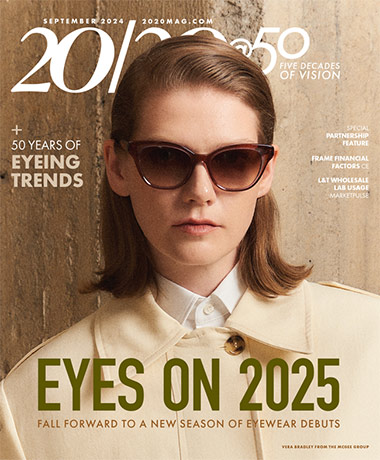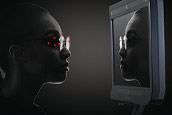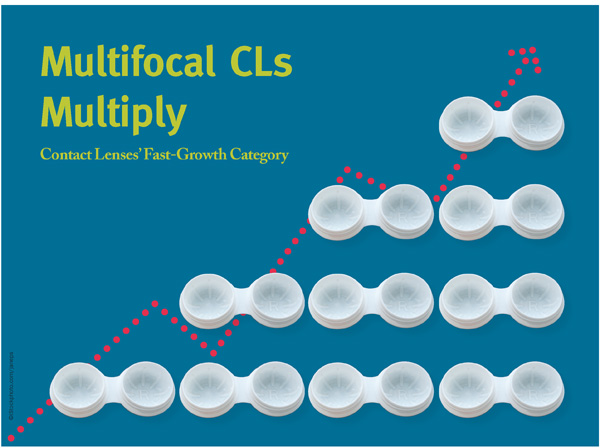
By Marge Axelrad Editorial Director
NEW YORK—One of the brightest spots in the vision care products arena — even in a most challenging economic climate — are multifocal contact lenses, as adult patients and ECPs are taking another look or even learning for the first time about the category.
Experts in the area point to several factors:
• Multifocal contact lenses are available in new materials and new designs from major players.
• More visible consumer marketing, via broadcast, print and the Web are raising awareness.
• Demographics are fanning waves of both emerging presbyopes and first-time CL wearers.
• Long-term single-vision CL wearers, facing presbyopia, have a strong desire to stay in CLs.
• More eyecare professionals with more confidence about successful multifocal contact lenses are moving beyond traditional monovision to fit pairs of the new lenses.
• Education on the category and expert tips on fitting techniques are helping ECPs generate patient satisfaction faster than ever before.
All of this activity is contributing to sharp increases. While still a comparatively small share of the overall U.S. contact lens market, multifocal contact lenses are growing by double-digits in terms of dollars and patient fits — about 12 to 15 percent this year compared to last — market experts tell VM.
Doug Brayer, marketing director at CooperVision, which has an extensive multifocal contact lens portfolio, noted, “Per HPR (Health Products Research, now doing business as inVenitv Advance Insights), in Q2 2009, the multifocal market represents just under 8 percent (7.9 percent) of the total soft CL market. To put this in perspective, in Q2 2007 multifocals represented 5.5 percent of the market.”
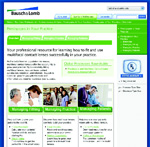
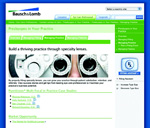
Bausch & Lomb has developed a comprehensive Web-based resource Web site, PresbyopesInYourPractice.com, with sections that offer insight and information for ECPs about recommending, managing and working with multifocal contact lenses. Doctor testimonials share practice success and fitting expertise. |


CooperVision recently changed the name of its multifocal for emerging presbyopes to Proclear EP. On its Web site, the company now has a clearly-designated area for presbyopes to learn about wearing contact lenses for the condition and about CooperVision’s Proclear series. |
“For both the mature presbyope and particularly the emerging presbyope, we are focusing on education to guide them in ways to move beyond a monovision approach to provide enhanced patient satisfaction with new lenses like our ProClear Multifocal Toric and our Proclear EP, which is the new name of our Biomedics EP lens.” The lenses are part of CooperVision’s PC Hydrogel family of daily wear lenses. Brayer pointed out, “By changing the name of the lens to Proclear EP, the material advantages associated with the lens will stay top of mind, and practitioners will be better positioned to discuss the unique benefits of the material with their patients. It will also allow practicioners to transition them more easily into Proclear Multifocal lenses—and keep them in the same brand—as their condition progresses.”
Added CooperVision’s James Gardner, senior director of marketing, “With just under 6 percent of the U.S. contact lens market in dollars involved in the category, when you think of the number of potential wearers that could be in this modality, you realize the huge untapped potential of multifocals.
“Existing contact lens wearers facing presbyopia already have their contact lens wearing habit entrenched and they are relatively easier to transition into multifocal lenses. First-time wearers, emmetropes who are encountering any vision correction for the first time require a bit more investment to point out contact lenses as an option, to point out and underscore the convenience, comfort and cosmetic aspects of contact lens wear,” he continued.
“Multifocal contact lenses are clearly moving out of the ‘novelty’ category. By prescribing multifocals, doctors are perceived in their patients’ eyes as a specialist, someone who can solve vision problems with contact lenses. There’s a lot of equity in that for the doctor and their practice,” Gardner said.
The potential, in terms of sheer number of patients, is underscored by Christopher Huels, senior product manager for multifocals at Bausch & Lomb. “We estimate that there are roughly eight million contact lens-wearing presbyopes out there between 40 and 45 years old. Half of these are putting reading glasses over the top of their contact lenses, many are in still using monovision to correct their vision.
Huels points out, “New designs provide binocularity and there’s huge upside potential now. Presbyopes’ vision requirements increase with age. The education challenge for patients and doctors is to talk about contact lenses as an option for people who’ve never needed vision correction and bring mature wearers into the category when many of them don’t even know that modern multifocals are even an option.”
Bausch & Lomb’s Goodbye Readers’ marketing campaign and related Web site is designed to tackle concerns head on, so patients can see the lens demo, download a trial certificate, learn more about their options and, with a doctor locator, find an ECP who can help them once they realize they can read and see distance at the same time via multifocal contact lens.
Citing a 2007 Gallup Study, Huels reports, “Sixty percent of presbyopes don’t know that multifocal contact lenses exist. And when they’re told about it, 70 percent of them want to try it.”
Goodbye Readers has successfully driven patients to learn more about Bausch & Lomb’s PureVision Multi-Focal contact lenses, Huels notes, adding, “Patients want them; docs need to have the conversation. And multifocals’ practice-building perspective is huge. When a doctor fits a presbyope into contact lenses and not reading glasses, that patient is ecstatic — that generates great ‘word of mouth.’”
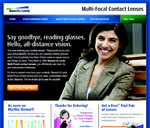
BB&L’s award-winning GoodbyeReaders.com site, reinforces the messages of the company’s consumer campaign, talks about Bausch & Lomb PureVision Multi-Focal options for presbyopes. |
Robinson continued, “We have many options, silicone hydrogel and more success. As I travel and lecture, I see that practitioners have been trying it, are anxious to learn new tips. Media and TV ads plus satisfied patient recommendations to friends and relatives have created a lot of buzz and it’s great to have something new and exciting to talk to patients about.”
Robinson points out that there are variants in “the discussion” with different types of patients. If it’s an existing contact lens wearer, she noted, “it can be more of a slam dunk conversation; these are patients that are familiar with CL regimens and are not as trepidatious of trying the new lenses. Emmetropes can be more of a challenge although they’re receptive to even learning about the option. Mature, over-50 patients who have been in monovision successfully are finding the disparity of one eye and the other eye creating problems. Maybe their add requirement is now a plus 2.25 or plus 2.5 and they are frustrated. But if the practitioner can talk with them about new options, they can really appreciate the idea of ‘putting their eyes back together’ with a pair of new multifocals.”
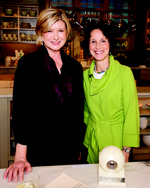
Rhonda Robinson, OD, right, recently enlightened Martha Stewart about multifocals on a health segment of the popular TV show. |
Robinson said, “My ‘aha!’ moment which I discuss with other doctors is: I don’t really find these lenses any different than fitting presbyopes into a PAL spectacle lens. If it’s the right prescription and a design that is right for a patient’s vision needs, ask them to ‘Try it, wear it for a week and we’ll see how it works.’ And really, you don’t have to make a change the majority of the time. Giving doctors permission to do that as opposed to having to make the lenses be perfect on day one, helps them view it as a adaptation issue. And really, today, doctors can feel as confident about multifocals as they do single-vision contact lenses. They are not exactly like PALs with a distinct distance, middle and reading zone — it’s a true simultaneous vision lens. So, don’t give up the ship.”
A spokesperson at Johnson & Johnson Vision Care provides additional perspective on the keen interest in the category. According to a 2008 Gallup poll, 56 percent of teenagers and 45 percent of young adults (aged 18-34) who need vision correction wear contact lenses. In the emerging to early presbyopic age bracket (35- to 49-year olds), the rate of contact lens wear drops to one-third. And only 7 percent of people over age 50 who need vision correction are wearing contact lenses. More than six in 10 adults ages 35-49 who wear contact lenses and eight in 10 of those over age 50 say they are interested in bifocal or multifocal contact lenses. Moreover, about one-third of adults who currently wear only spectacles say they are interested in trying (or returning to) contact lens wear. Further, Johnson & Johnson Vision Care cites data that says, by their late 30’s/early 40’s, many contact lens patients are struggling not only with presbyopia, but also with dryness and discomfort. In a number of studies, discomfort is the biggest reason cited by patients for discontinuing contact lens wear.
Johnson & Johnson Vision Care debuted its Acuvue Oasys brand for Presbyopia across the U.S. this year, the first new multifocal lens from the company in 11 years.

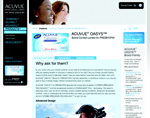
The company debuted Acuvue Oasys for Presbyopia earlier this year, its first new lens in the multifocal category in 11 years. Johnson & Johnson Vision Care’s Vistakon Americas president, Dave Brown, told Vision Monday, “With a generation of people growing up wearing contact lenses and an increasingly large number of presbyopes out there, we are very optimistic about the multifocal category.”
Johnson & Johnson Vision Care is preparing initiatives to educate doctors about its lens and its recommended fitting process to increase penetration into the arena.
To facilitate the fitting process of emerging and early presbyopic patients, Vistakon has developed a clinically-validated fit procedure to help doctors select the logical first lens pair and quickly determine if it is the optimal choice for the patient. The company created the tool from research gleaned from nine substantive crossover clinical trials involving 890 patients. Vistakon tested the complete range of all the possible combinations of lens pairs for each add on patients representative of the entire range of presbyopes.
Specifically, the tool consists of tables that shows doctors how to fit the dominant/non-dominant eye by add power needed. It provides doctors with a first choice and then a second visit adjustment depending on whether the patient needs better near or distance vision. Essentially, the tool limits the typical fit tweaking and experimenting by identifying the lens pair that will result in the highest probability of success based on the patient’s current spherical refraction, add power and eye dominance.
Doctors who have been working with the lens report a 74 percent fit success in one fit and follow-up visit measured by both doctor approval and patient satisfaction with lens performance. More than eight out of 10 (83 percent) of patients who were successfully fit reported Acuvue Oasys for Presbyopia provides balanced near and distant vision throughout a wide range of daytime and evening activities involving varied lighting conditions.
Said Brown, “Acuvue Oasys for Presbyopia is a major opportunity for ECPs to meet the comfort and vision requirements of patients, while minimizing the frustration often associated with the fitting process.” ■



